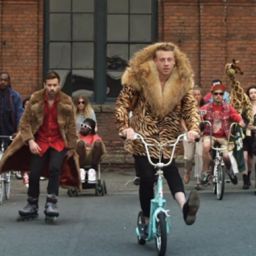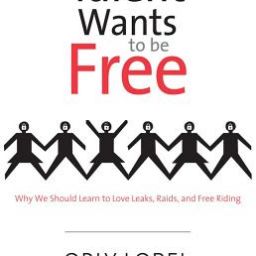
Which of these is acceptable under copyright law? Republishing books when their authors are almost definitively dead to save a dying culture? Publishing collections of unpublished ephemera, such as love letters and candid photos when the creators are unknown? Ensuring that historic sound recordings are preserved? Or repurposing the writings of a dead author to sell products completely unrelated to that author, if the heirs give permission?
Oddly enough, even though the last option seems somehow wrong, it is the only option that is presently acceptable under U.S. copyright law. Some actual examples of cultural preservation that are culturally acceptable, but not legal revolve around orphan works, likely copyrighted works where it is difficult or nigh impossible to determine ownership. In the U.S., many works published from 1923 and onward fall are orphaned. As described by Lawrence Lessig,
‘”orphan” works [] “fall into a black hole of regulatory uncertainty.””You have films from the 1930s and you can’t identify who the copyright owners are so you can’t restore them and make them accessible,” he said. “What we’re talking about is this class of work where there is no known present owner to come forward. So the work cannot be made available.”‘
Republishing books when their authors are almost definitively dead to save a dying culture?
The National Yiddish Book Center was founded by Aaron Lansky, author of Outwitting History, who in response to
thousands of priceless Yiddish books – books that had survived Hitler and Stalin – were being discarded and destroyed. As an older generation passed on, more often than not their precious Jewish volumes were literally thrown in the trash by children and grandchildren unable to read the language. An entire literature was on the verge of extinction.
The Center [has] recovered … 1.5 million volumes…. The Center’s achievement has been hailed as the “the greatest cultural rescue effort in Jewish history.”
Not only has the Center collected books, it also republishes them from the Stephen Spielberg Digital Library:
[with] pioneering program to digitize the titles in our collection and make high-quality reprints available on demand. Our easy-to-use online catalog means that Yiddish, once the most endangered of literatures, is now the safest and most accessible.
Most of the books republished are within the copyright term either in the the U.S., or in Europe, such as Germany, assuming death in 1945, under copyright “protection” until 2015. Should the Center be tracking down the heirs of all of the authors they republish? According to copyright, the answer is yes, because there isn’t an exception for saving culture from destruction. To follow copyright formalism to such a degree is a strange combination of sad and ironic and disturbing. It would be wrong to allow the words of those killed in the Shoah to be a modern-day Ozymandias, works crumbling away into nothingness.
Publishing collections of unpublished ephemera, such as love letters and candid photos when the creators are unknown?
While the National Yiddish Book Center collects and reprints items to save an entire culture, on the other hand, Found Magazine collects and republishes the ephemera of life, such as shopping lists and notes passed in class. The publishers print the magazine “so that everyone can check out all the strange, hilarious and heartbreaking things people have picked up and passed our way.” The culture being preserved in Found is the type that we all create — and throw away or forget about (or in the case of Dirty Found, perhaps items that people would prefer to ignore ever existed).
Considering the items are found items (hence the title) and mostly anonymous, the publication does not ask for permission of the copyright owner. And who would think about their to-do list as being copyrighted? For 120 years? Found Magazine purposely collects items likely to not last 120 hours or days, let alone years, so readers can revel, weep, and laugh at the banalities of everyday life.
Ensuring that historic sound recordings are preserved?**
In the U.S., sound recordings made pre-1972 will not enter the public domain until 2067. This means that all of the early recordings, including those with significant historical and cultural significance are locked up by copyright. Examples include early blues recordings, regional folk songs, and other materials that there may be no living person with direct knowledge of the songs. Considering that format shifting isn’t allowed, if the recordings dissolve or their are no more players — too bad! On the other hand, in the U.K. (at present) has a copyright term of 50 years for sound recordings, allowing for early recordings to be republished and angering aging U.K. rockers.
Some of the only clearly public domain sound recordings/ transcripts are from the WPA / Federal Writers’ Slave Narrative Project, so think about all of other possible culturally significant sound recordings that are locked up until 2067.
For example, the band, Tomahawk, based their latest album, Anonymous, on the Native American recordings researched by its guitarist, Duane Denison and Hank Williams III. Tomahawk’s label’s official site states
[Anonymous] reverentially explores and reinterprets the darker, more recessed ancestral music created by North America’s indigenous people, the title reflects the countless individuals who contributed to these songs but went un-credited throughout history. … Duane began to research [Native American] music ; … he found books that were written around the time of Teddy Roosevelt’s presidency, a period in U.S. history when Indian culture and artifacts were in vogue. The books, dated to the early 20th century, recorded transcriptions of the songs [used on the album].
Repurposing the writings of a dead author to sell products completely unrelated to that author?
On the other hand, often when famous people die, their images and words are used in ways that can go against what fans and critics think fits. For example, after Dr. Seuss died, his works were commercialized by his widow. Or in a recent case, the works of Frank Zappa are being limited by his.
In another example, with larger cultural resonance, since the death of Martin Luther King, his family has authorized the use of his copyrighted works in some very non-civil rights ways … and has limited use of his words. The family was left with little money, so it makes sense why they would view MLK’s works as their legacy, after all, under the law, it belongs to them — not the public at large.
In response to one Martin Luther King ad for trucks, one critic stated:
“I feel a little violated when I watch it … I don’t mind when they have a tent
sale on President’s Day, but those guys have been dead for 200 years. I’m not
sure I’m ready for a Rosa Parks sale-a-bration.”
Presently, copyright law is about the rights of individuals to control … , without an allowance for the idea of cultural ownership for works within the copyright term. This has led to the creation of licensing schemes like Creative Commons — considering how difficult it is to officially give a work to the public domain. And to the serious problem of orphan works, leading to the slow melting away of culture, especially 20th century culture, due to our fears of copyright. At least there are people and organizations like the National Yiddish Book Center willing to risk violating copyright to preserve culture.
Let us praise those that help preserve culture, not bury them, as copyright law does by default.
(picture of the Elgin Marbles to remind us that preserving culture means different things to different groups of stakeholders)
** yes, I realize there is a difference between recordings and transcribed notation or transcripts, but the overall point remains




[…] So here we have a controversy about items that would not exist but for ignoring the express wishes of their creator! I’ve previously discussed the copyright-ignoring efforts of the National Yiddish Book Center to save Yiddish books that would have been lost and Found Magazine coll…. […]
[…] https://thelearnedfangirl.com […]